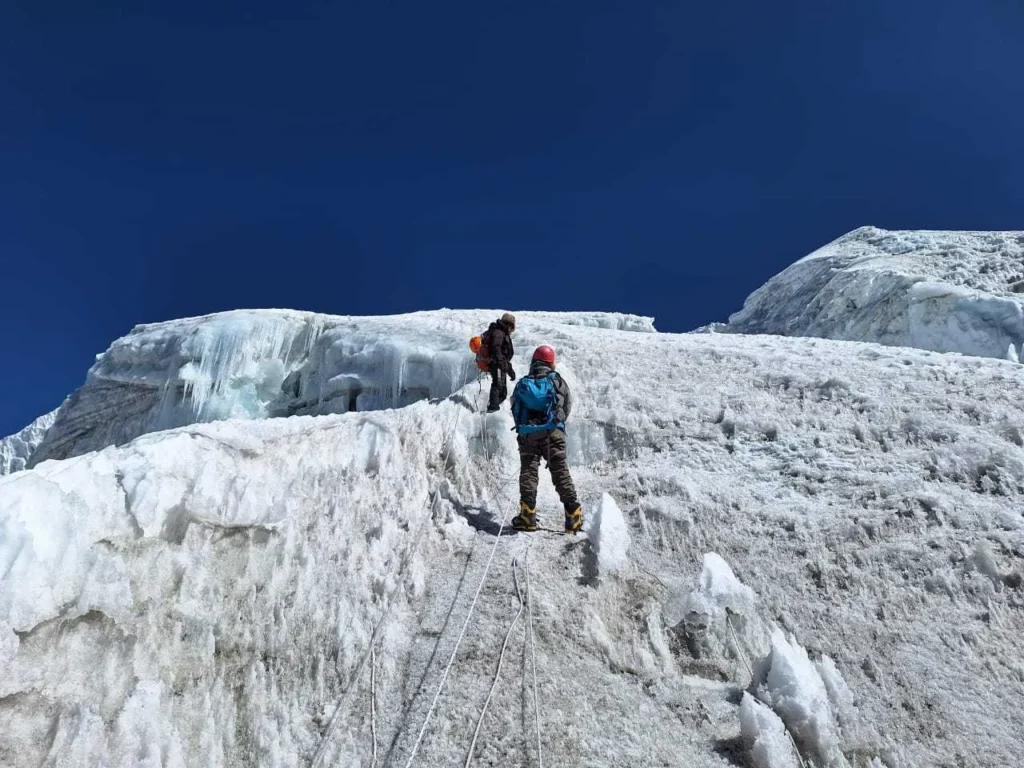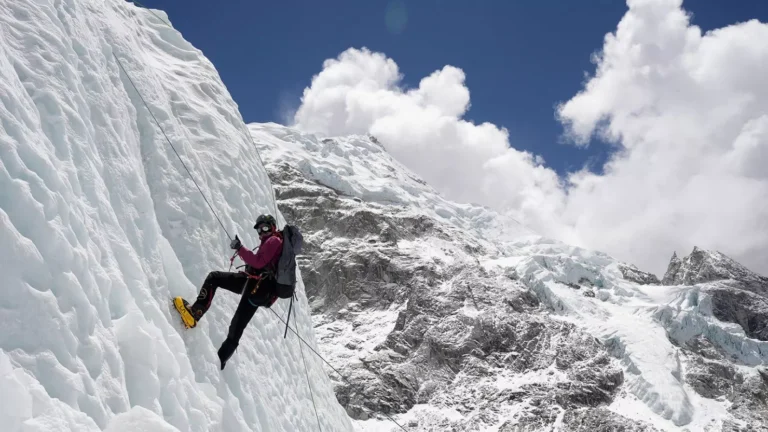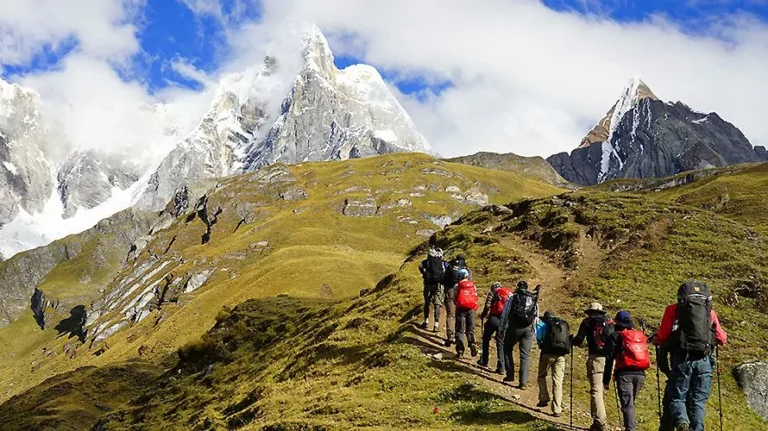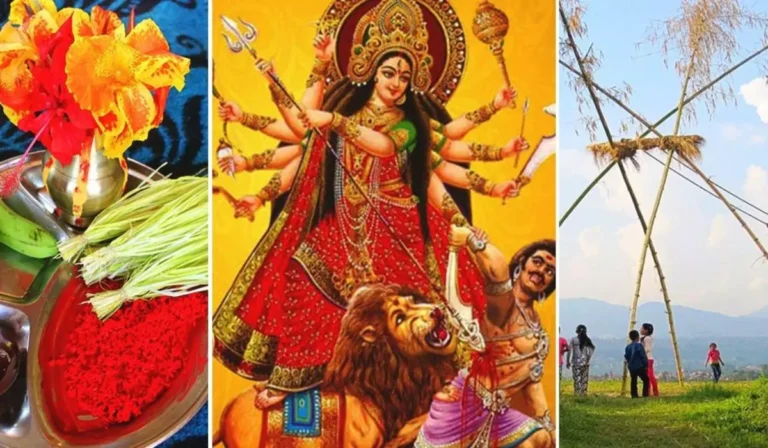- PUBLISHED
How to Prepare for Mountain Climbing: Essential Tips

Climbing a mountain is one of the most exhilarating and challenging adventures you can undertake. Whether you’re eyeing a snow-capped peak or a rugged alpine route, the key to a safe and successful experience lies in solid preparation. In this guide, we’ll explore how to prepare for mountain climbing: essential tips, training methods, gear advice, and mental strategies to get you started on the right foot.
What is Mountain Climbing
Before we get into climbing a mountain, we need to understand what mountain climbing is. Mountain climbing, also known as mountaineering, involves ascending mountainous terrain using a mix of hiking, trekking, and technical climbing skills. Unlike casual hiking, climbing a mountain in Lobuche Peak in the Everest region often means facing high altitudes, variable weather, and physically demanding routes that require serious training to climb and preparation.
Types of Mountain Climbing
Mountain climbing is not one-size-fits-all. For example, Mera Peak offers a mix of trekking and non-technical mountaineering, ideal for those beginning their mountaineering training
There are various types, each with different levels of difficulty and technical requirements:
- Alpine Climbing: Fast-paced climbs that combine ice, rock, and snow.
- Expedition Climbing: Long-duration climbs at high altitudes that demand advanced mountaineering training.
- Rock Climbing: Focused on vertical or steep rock surfaces using ropes and gear.
- Ice Climbing: Involves climbing frozen waterfalls or icy slopes.
- Scrambling: A less-technical blend of hiking and climbing using hands for balance.
Each type of mountain climbing involves a different level of mountain training and experience, so choosing the right one depends on your current fitness and skill level.
Preparing for Mountain Climbing
Training, planning, and having the right gear are the foundation of any successful climb. This section focuses on how to prepare physically and mentally for climbing a mountain so you’re confident and ready when the time comes. Before you start mountain climbing, you can learn how to prepare for high altitude hiking, which can make your training safer and your summit experience more enjoyable.
Choosing the Right Climb
- Start with a suitable peak: Pick a mountain that matches your current fitness level, technical skills, and mountaineering experience.
- Research the terrain: Understand whether the route includes rock, snow, ice, or a mix, and how that affects difficulty.
- Climb Options: Look into adventures that offer a wide range of trekking and climbing experiences ideal for all skill levels.
- Check elevation gain: Know how much altitude you’ll be gaining to assess the physical demand and plan your mountain training accordingly.
- Consider seasonal conditions: Weather can dramatically impact safety, especially in high-altitude regions.
- Set realistic goals: Choosing the right objective early helps focus your training to climb a mountain safely and effectively.
- Explore good starter options:
- Mera Peak Trek & Climb: This Mera Peak Trek is a great introductory high-altitude climb for beginners with basic mountaineering skills.
- Everest Base Camp Trek with Lobuche Peak: This Everest Base Camp Trek is ideal for those looking to combine trekking with a more technical summit experience.

Physical Preparation for Mountain Climbing
Mountain trekking training should ideally begin at least 8 to 12 weeks before your planned expedition to build the endurance and strength needed for the climb. Day hikes like Jamacho Gumba are ideal for building baseline fitness and testing gear before committing to multi-day expeditions. A balanced training routine includes:
- Cardio Workouts: Activities like hiking, jogging, or cycling improve cardiovascular fitness essential for sustained climbing efforts.
- Strength Training: Exercises such as squats, lunges, deadlifts, and core workouts build the muscle strength needed to carry your pack and tackle steep terrain.
- Backpack Training: Simulate the actual climb by hiking with your full gear to get used to the added weight and improve stamina.
- Altitude Simulation (if possible): Gradually increasing elevation during training hikes helps your body adapt to lower oxygen levels, reducing the risk of altitude sickness.
A structured mountain training plan will condition your body, improve endurance, and prepare you for the physical demands of summit day.
Mental and Emotional Preparation
Training to climb a mountain also means developing a strong and adaptable mindset. Mountain environments can be unpredictable and uncomfortable, so mental resilience is just as critical as physical strength. Here are some key ways to prepare mentally and emotionally:
- Practice enduring discomfort: Simulate physically and mentally challenging conditions during training to build tolerance for fatigue, cold, and long hours.
- Use visualization techniques: Mentally walk through each stage of the climb—gear setup, tough ascents, summit push—to build confidence and reduce anxiety.
- Stay calm under pressure: Train your ability to manage fear and stress through breathing exercises, meditation, or real-life exposure to stressful environments.
- Understand and respect your limits: Recognize signs of physical and mental fatigue and be prepared to turn back if necessary.
- Prepare for the unknown: Expect unexpected situations and mentally rehearse your response strategies so you don’t panic during the real climb.
Essential Gear and Clothing Checklist
Having the right gear is a critical part of effective mountaineering training. Essential items include:
- Clothing Layers: Use a layering system with a moisture-wicking base layer, insulating mid-layer, and wind/waterproof outer shell to stay warm and dry.
- Footwear: Properly fitted mountaineering boots paired with warm, breathable socks provide support and comfort on varied terrain.
- Climbing Equipment: Helmet, harness, crampons, ice axe, and rope are essential for safety and technical sections.
- Other Essentials: Sunglasses, gloves, headlamp, hydration system, and emergency supplies such as a first aid kit and whistle.
Familiarize yourself with all your gear well in advance, and practice using it during your mountain trekking training hikes so that everything feels natural on climb day.
Climbing Safety and Risk Management
Safety should always be your top priority when climbing a mountain. Key precautions include:
- Learn Basic First Aid: Be prepared to treat minor injuries and recognize symptoms of altitude sickness or hypothermia.
- Understand Altitude Illness: Know how to identify acute mountain sickness, and the proper steps for acclimatization or evacuation if symptoms worsen.
- Carry Communication Devices: A satellite phone or GPS beacon can be a lifesaver in emergencies where cellphone coverage is unavailable.
- Share Your Itinerary: Always inform a trusted person about your planned route and expected return time.
- Monitor Weather Conditions: Keep an eye on forecasts and be prepared to postpone or abort the climb if conditions deteriorate.
- Have a Turnaround Plan: Be willing to turn back if safety is compromised—reaching the summit is never worth risking your life.
- Regularly Check Your Gear: Inspect equipment for damage before and during the climb to avoid malfunctions.
- Train for Emergency Scenarios: Practice evacuations and problem-solving drills to improve your response if something goes wrong.
Implementing these risk management strategies into your mountaineering training prepares you not only physically but also mentally for a safer climb.
Mountain Climbing Explained: Skills, Challenges, and Rewards
Climbing a mountain involves more than just reaching the summit. It’s a complete test of your physical abilities, mental toughness, and technical knowledge. If you’re new to high altitudes, treks like the Mardi Himal Trek help build your mountain trekking training base while still challenging your endurance. This section explores the skills required, the challenges you’ll face, and the powerful rewards that come with the journey.

Skills Required for Mountain Climbing
To climb a mountain safely and confidently, you’ll need a solid mix of fitness, technical ability, and decision-making skills. Training to climb effectively means focusing on these key areas to build the strength and knowledge necessary for success.
Physical Endurance and Strength
Climbing a mountain requires a high level of cardiovascular endurance, leg power, and core stability to carry gear, ascend steep slopes, and push through long hours of exertion. Strength training targeting the legs, glutes, and lower back is equally important for rugged terrain and reducing injury risk.
Technical Climbing Skills
Climbing a mountain often involves navigating steep rock faces, snowfields, or icy slopes, all of which demand proper use of technical gear. These skills are essential for training to climb a mountain. Enrolling in a mountaineering training course allows you to gain confidence with your gear.
Navigation and Route Finding
When climbing a mountain, knowing how to navigate through unfamiliar, often unmarked terrain can be lifesaving. This includes reading topographic maps, using a compass, interpreting contour lines, and understanding GPS tools. Poor navigation can lead to lost time, exhaustion, or danger.
Decision-Making and Risk Assessment
Mountains are unpredictable environments, and every climber, whether professional or beginner, must be prepared to make smart decisions in high-stress situations. Climbing a mountain with training includes learning how to evaluate weather patterns, terrain hazards, altitude risks, and the physical or mental state of your team. These are skills that develop with experience and proper training.
Challenges Faced in Mountain Climbing
Climbing a mountain isn’t easy as it sounds. Sudden weather changes and altitude shifts can pose a challenge to unprepared trekkers. From altitude issues to mental fatigue, here are some of the most common obstacles and how to prepare for them.
Altitude and Weather Conditions
At high elevations, oxygen levels drop significantly, which can result in altitude sickness, causing headaches, nausea, fatigue, and even more severe complications like pulmonary or cerebral edema. To make matters worse, while climbing a mountain, weather can shift without warning, turning a sunny day into a snowstorm in minutes.
Physical Fatigue and Injuries
Long days of steep ascents, carrying heavy gear, and navigating rough terrain while climbing a mountain wear down your muscles, joints, and energy reserves. Blisters, muscle strains, and knee injuries are common. That’s why a well-rounded training plan to climb a mountain is vital, one that includes endurance workouts, strength training, and proper rest cycles.
Mental and Emotional Stress
Solid mountaineering training should go beyond just physical preparation; it should also focus on building mental resilience. Techniques like visualization and breathing exercises can prepare you for mentally taxing situations. Practicing climbing a mountain and team exercises during mountain trekking training can also help you develop trust and emotional endurance.
Gear Malfunctions or Logistical Issues
Even with the best plan in climbing a mountain, equipment failure and logistical hiccups can arise. Crampons might break, water filters may clog, or navigation devices could lose signal. Effective mountain training should include gear checks, backup systems, and drills that simulate gear failure scenarios.
Rewards of Mountain Climbing
Despite the challenges, climbing a mountain offers unmatched emotional, spiritual, and physical rewards. Once you finish training to climb a mountain, it often rewards you with remote beauty. Here’s what keeps people going back to the peaks.
Personal Growth and Resilience
Successfully climbing a mountain means confronting and overcoming a variety of fears, physical exhaustion, and unexpected obstacles. The discipline and perseverance gained through training to climb a mountain translate into improved problem-solving skills and emotional strength.
Building Lifelong Friendships and Community
Climbing a mountain often involves teamwork, trust, and shared challenges that create strong bonds among climbers. Your training to climb can often lead to these friendships, built through mutual support and shared adventure, that often last a lifetime and enrich the overall mountaineering experience.
Scenic Beauty and Solitude
Few experiences can compare to witnessing the breathtaking beauty of a sunrise from a remote mountain summit or standing above a sea of clouds with the proper training to climb. The landscapes encountered during mountain trekking training and the snow-capped peaks, alpine meadows, and crystal-clear streams provide lasting memories and a renewed appreciation for the natural world.
Spiritual Awakening and Adventure
Climbing a mountain can be both a physical challenge and a path toward personal enlightenment. For many climbers, the act of climbing goes beyond physical achievement. It becomes a deeply spiritual journey that fosters mindfulness, inner clarity, and a profound connection with nature.
Best Time to Mountain Climb
Choosing the right time to go climbing a mountain is just as important as your physical and mental preparation. Weather conditions, snowpack levels, and trail accessibility vary drastically depending on the season and the region.
- Spring (March to May) is a great time for climbs in regions like the Himalayas, with more stable weather and blooming landscapes.
- Summer (June to August) offers good climbing conditions in alpine areas, especially in Europe and North America, but monsoon rains affect regions like Nepal.
- Autumn (September to November) is widely considered the best time for mountain trekking in Nepal due to clear skies and moderate temperatures. Many climbers choose this season for ascents like the Mera Peak Trek.
- Winter (December to February) brings extreme conditions—ideal only for highly experienced climbers with advanced mountaineering training.
Make sure to time your expedition according to your destination’s weather patterns and your level of training to climb a mountain safely and successfully.

Conclusion
Climbing a mountain is more than a physical feat; it’s a transformative journey that challenges your body, mind, and spirit. From structured mountain training and gear preparation to developing emotional resilience, every aspect of preparation contributes to a safer and more fulfilling climb. Start by choosing the right mountain, time your expedition wisely, and gradually build your skills and confidence through mountain trekking training. Whether you’re heading toward the Everest Base Camp with Lobuche Peak or exploring other thrilling adventures in Nepal, remember that proper preparation is key.
Ready to make your mountain climbing adventure happen? Connect with our experienced guides who can support you from training to summit. Contact us today and get in touch with BeThere for personalized advice and assistance on your journey.
Table of Content
Frequently Asked Questions
What is mountain climbing?
Mountain Climbing, also known as mountaineering, is a sport or activity of climbing a mountain. It requires you to ascend and descend difficult terrain at high altitudes. It is a physically demanding activity that lasts multiple days or weeks, depending on the size of the mountain.
How to prepare for climbing a mountain?
To prepare for climbing a mountain, you can take these steps:
- Find a suitable peak
- Understand the terrain
- Cardio Workout
- Strength Training
- Endurance Training
- Packing the right equipment
- Interval Sessions
What are the challenges I can face when mountain climbing?
The challenges you can face when mountain climbing are:
- Weather Condition
- Altitude Sickness
- Physical Fatigue and Injuries
- Mental and Emotional Stress
- Gear Malfunction
When is the best time to go mountain climbing?
The best time to go mountain climbing is during the Autumn season (Sept-Nov), during this season the weather is perfect for mountain climbing as the skies are clear and the temperature is moderate.
What is the essential gear I should carry when mountain climbing?
The essential gear you should carry when mountain climbing is:
- Climbing Bag – to carry all the essential gear
- Rope: for safety and crevasse rescue on glaciers
- Harness: Securely attaches you to the rope
- Crampons: Provide traction on snow and ice
- Ice Axe: Aids in balance and self-arrest on icy slopes
Does mountain climbing require any skill?
Yes, mountain climbing requires a range of skills that can be trained over time. The skills you require are:
- Technical Skill – Learning how to use a harness, rope, crampons, etc
- Navigation – able to read maps, a compass, and understand terrain
- Environmental Awareness- Understanding the mountain environment, weather patterns, and potential hazards
- Fitness – Mountain climbing can be physically demanding, requiring strength, endurance, and stamina
Need help choosing a trail?
Connect with a local and plan your perfect trek.



